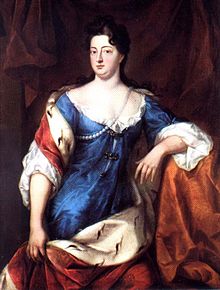Friedrich Wilhelm Weidemann
Friedrich Wilhelm Weidemann , occasionally also: Wiedemann written, (* 1668 in Osterburg ; † December 25, 1750 in Berlin ) was a German painter. From 1702 he worked as court painter to the prince and (later) Prussian king Friedrich Wilhelm I and created numerous portraits of the Prussian royal family.
birth
Friedrich Wilhelm Weidemann was born in 1668 in Osterburg, now in Saxony-Anhalt, in the old Mark Brandenburg.
education
Weidemann learned the art of painting from the Dutch painter and architect Rutger von Langerfeld , who had worked at the court of Elector Friedrich Wilhelm since 1678. Further pupils of van Langevelt were Samuel Theodor Gericke and Langevelt's son Wilhelm van Langevelt.
Weidemann completed his training by studying at the Berlin Academy of the Arts and then worked for some time in London under Gottfried Kneller , the court painter of the British King who came from Lübeck .
Court painter in Berlin
After his return to Berlin, Friedrich Wilhelm Weidemann - as Heinecken reports - was introduced to King Friedrich I by the influential Countess Katharina von Wartenberg, wife of the Prussian Prime Minister Johann Kasimir Kolbe von Wartenberg , and appointed court portrait painter in 1702. He first became a professor and later, as the successor to Samuel Theodor Gericke, also director of the Berlin Academy. In his role, Weidemann made numerous portraits of the Prussian royal family, in particular of the Prussian Queen Sophie Charlotte . Some of his pictures of the queen can be seen today in Berlin's Charlottenburg Palace , others in the palace in Königs Wusterhausen.
His younger cousin, Carl Emil Weidemann (* 1685; † 1735), also pursued a parallel career as a court painter. Like Friedrich Wilhelm Weidemann, Carl Emil Weidemann had worked for a time in London under Gottfried Kneller. He later painted portraits in Berlin and became court painter to Queen Sophie Dorothea . Carl Emil Weidemann died in 1735 at the age of 50.
Friedrich Wilhelm Weidemann's pictures were very popular with his contemporaries and he maintained his preference as a painter for a long time under King Friedrich Wilhelm I's government, but finally had to give way to the French painter Antoine Pesne , who was still the father of Prince Friedrich Wilhelm, the Prussian King Friedrich I. In 1710 he was called to Berlin, where he was officially appointed court painter on May 6, 1711.
Activity as an academic teacher
Weidemann became a full adjunct and member of the Berlin Academy of Arts in 1708. In 1712 he was appointed rector and in 1718 director of the academy, which he subsequently chaired repeatedly until his death. From 1730 onwards he mainly taught as a professor of perspective.
The artists GP Busch, AB König, Jakob Wilhelm Heckenauer, John Smith, Johann Jakob Haid u. a. have made copper engravings based on models by Friedrich Wilhelm Weidemann .
death
Friedrich Wilhelm Weidemann died on December 25, 1750 in Berlin at the age of 82.
literature
- Johann Rudolf Füssli: General Artist Lexicon . Zurich 1779.
- Johann Rudolf Füssli: General artist lexicon . Zurich 1806.
- Karl Heinrich von Heinecken: News from artists and art things. Part 1. Verlag Johann Paul Krauss, Vienna 1768.
- Rudolf G. Scharmann: Charlottenburg Palace. Royal Prussia in Berlin. 4th edition Prestel-Verlag, Munich a. a. 2010, ISBN 978-3-7913-2815-7 .
Web links
- Friedrich Wilhelm Weidemann. In the registers of the Berlin Academy of the Arts.
Remarks
- ^ Füssli: Artist Lexicon . 1779, p. 707.
- ↑ Heinecken: Nachrichten ... 1768, p. 87.
- ^ Füssli: Artist Lexicon . 1806, p. 5013.
- ↑ Scharmann: Schloss Charlottenburg ... 2010, p. 4 and front cover (inside).
- ↑ cf. Claudia Sommer / Heinrich Hamann: Castle and garden of Königs Wusterhausen . Potsdam, 2nd edition 2002. Ed. By the Prussian Palaces and Gardens Foundation , p. 17.
- ^ Füssli: Artist Lexicon . 1779, p. 707.
| personal data | |
|---|---|
| SURNAME | Weidemann, Friedrich Wilhelm |
| ALTERNATIVE NAMES | Wiedemann, Friedrich Wilhelm |
| BRIEF DESCRIPTION | German painter |
| DATE OF BIRTH | 1668 |
| PLACE OF BIRTH | Osterburg |
| DATE OF DEATH | December 25, 1750 |
| Place of death | Berlin |

